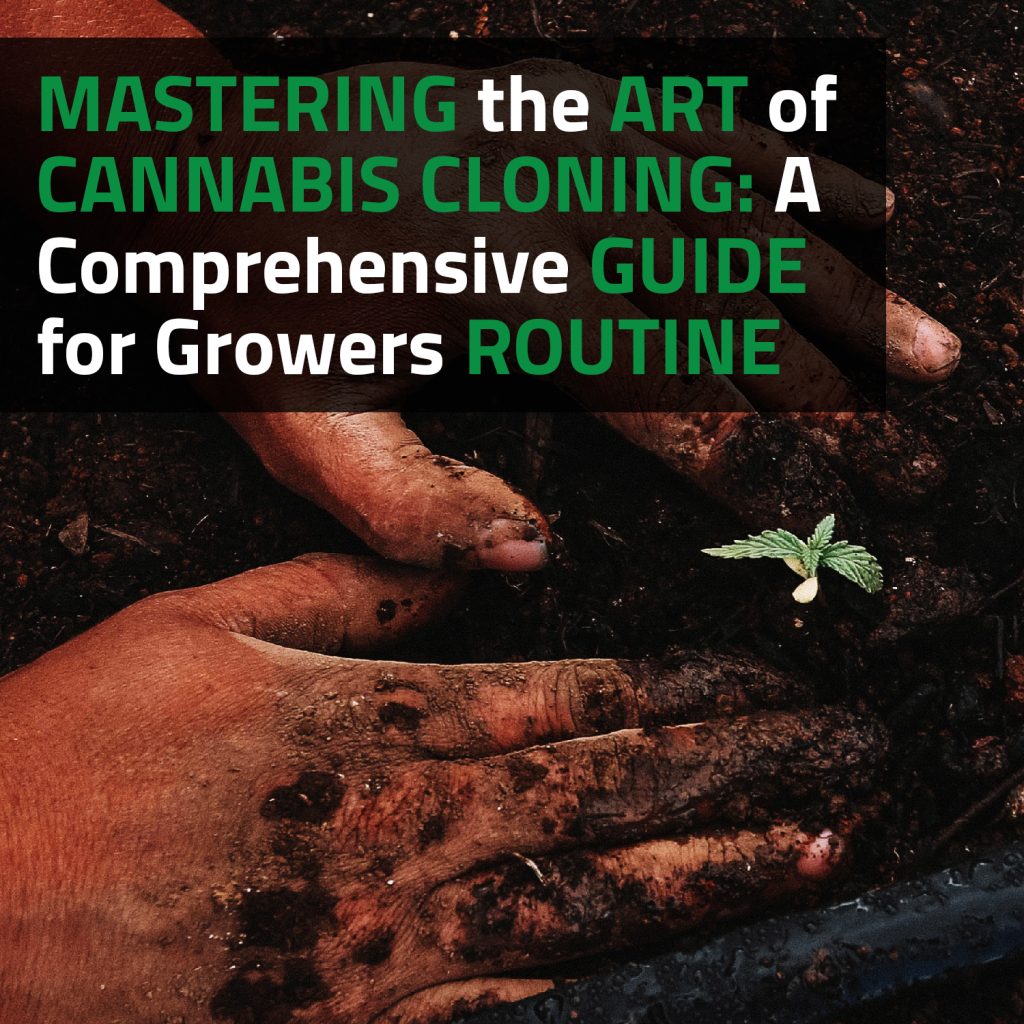Cannabis cloning has emerged as a popular technique in the world of cannabis cultivation, allowing growers to reproduce genetically identical plants with desirable traits. With the increasing demand for specific strains and consistent quality, mastering the art of cannabis cloning has become essential for both experienced and aspiring cultivators.
This comprehensive guide is designed to provide growers with a deep understanding of the cloning process, from the fundamentals to advanced techniques. Whether you’re a hobbyist looking to expand your garden or a legal commercial grower aiming for consistent production, this article will equip you with the knowledge and skills necessary to achieve successful cannabis cloning.
Getting Started: Essential Tools And Equipment For Successful Cannabis Cloning
To embark on a successful cannabis cloning journey, it is essential to have the right tools and equipment at your disposal. Each stage of the cloning process requires specific instruments and materials that promote healthy root development and ensure optimal conditions for the clones. Here are some essential tools and equipment you’ll need to get started:
- Cloning dome or propagation tray: A cloning dome or propagation tray serves as a controlled environment for the clones during the rooting phase. It helps maintain high humidity levels, which are crucial for root development. Look for a dome or tray with a clear, transparent cover that allows light penetration and ventilation.
- Cloning medium: A suitable cloning medium is necessary to support root growth and provide stability to the clones. The most commonly used cloning medium is rockwool cubes or plugs. They provide excellent water retention and aeration, promoting healthy root development. Other options include peat pellets, coco coir, or specialised cloning gels.
- Scalpel or razor blade: A sharp and sterile cutting tool is essential for taking cuttings from the mother plant. A scalpel or razor blade allows for clean and precise cuts, minimising damage to the plant tissues. Ensure that your cutting tool is properly sterilised to prevent the introduction of pathogens that could harm the clones.
- Rooting hormone: Rooting hormone is a beneficial substance that stimulates the formation of roots on the cuttings. It enhances the success rate of cloning by promoting rapid and robust root development. Rooting hormone is available in various formulations, such as gels, powders, or liquids. Choose a reliable brand and follow the instructions for proper application.
- Spray bottle or mist atomizer: Maintaining the right humidity levels is crucial during the early stages of cloning. A spray bottle or mist atomizer helps you mist the clones and the inside of the cloning dome, ensuring a moist environment. Use distilled water or a mild nutrient solution to prevent contamination and mineral buildup.
- Heat mat: A heat mat placed under the cloning dome or propagation tray helps provide consistent bottom heat to the clones. This warmth stimulates root growth and accelerates the cloning process. Choose a heat mat with adjustable temperature settings and ensure it is designed for horticultural use.
- pH and EC metres: Monitoring the pH (acidity/alkalinity) and electrical conductivity (EC) of your cloning water or nutrient solution is necessary for maintaining optimal nutrient uptake and preventing nutrient imbalances. pH and EC metres allow you to measure and adjust the pH and nutrient strength of your water or solution accurately.
- Grow lights: Although not necessary during the initial rooting phase, providing adequate light to the clones once they have rooted is vital for their overall growth and development. LED grow lights or fluorescent lights with a spectrum suitable for vegetative growth can be used to provide the necessary light intensity and spectrum.
- Sterilisation supplies: Maintaining a clean and sterile environment is crucial to prevent the spread of diseases and ensure the health of your clones. Stock up on isopropyl alcohol or hydrogen peroxide for sterilising tools and surfaces, as well as gloves and clean, lint-free cloths for wiping down equipment.
- Watering can or syringe: Once your clones have rooted and are ready for transplantation, you’ll need a watering can or syringe for precise and controlled watering. This allows you to deliver the right amount of water or nutrient solution to each clone without causing excessive moisture or overwatering.
Selecting The Right Mother Plant: Key Considerations For Cloning Success
Choosing the right mother plant is a critical step in cannabis cloning that significantly impacts the success and quality of your clones. The mother plant serves as the source of genetic material for cloning, so it is essential to select a healthy and vigorous plant with desirable traits. Here are some key considerations to keep in mind when selecting the right mother plant for successful cannabis cloning:
- Health and vigour: Opt for a mother plant that exhibits robust health and vigour. Look for plants with vibrant green foliage, strong stems, and an overall healthy appearance. Avoid selecting plants with signs of disease, pest infestations, nutrient deficiencies, or other stress-related issues. Healthy mother plants are more likely to produce strong and resilient clones.
- Genetic desirability: Consider the specific traits and characteristics you want to replicate in your clones. This could include factors like desired cannabinoid profiles, aroma, flavour, yield potential, growth pattern, or any other unique qualities you value in your cannabis plants. Select a mother plant that possesses these desired traits to ensure the clones inherit them accurately.
- Pest and disease resistance: It is advisable to choose a mother plant with a history of resistance to common pests and diseases. This reduces the risk of propagating clones that are susceptible to infestations or infections. By selecting a mother plant with natural resistance, you increase the chances of producing healthy and resilient clones that can withstand environmental challenges.
- Age and stability: Select mother plants that are in the vegetative stage and have reached a stable growth phase. Cloning from mature and stable mother plants ensures that the clones will exhibit consistent growth patterns and traits. Avoid selecting plants that are too young or still going through significant vegetative or flowering changes, as this can lead to variability in the cloned plants.
- Growth rate and branching: Consider the growth rate and branching structure of the mother plant. Choose plants that exhibit desirable growth characteristics, such as vigorous growth, branching density, and lateral shoot development. Mother plants with ample branching and a bushy structure tend to produce more viable clones with increased potential for high yields.
- Compatibility with growing environment: Take into account the specific growing environment in which the clones will be cultivated. Consider factors such as temperature, humidity, light intensity, and available space. Select a mother plant that thrives in similar environmental conditions to ensure the clones will adapt well and continue to flourish.
- Clonal history: If possible, gather information about the clonal history of potential mother plants. Consider factors such as their performance in previous cloning cycles, success rates of rooting, and overall health of the resulting clones. This information can provide insights into the suitability and reliability of a particular mother plant for cloning purposes.
- Documentation and labelling: It is important to maintain accurate documentation and labelling of each mother plant. Clearly mark each plant with relevant information, including the strain name, date of cloning, and any specific traits or characteristics of the plant. This ensures traceability and helps you keep track of the performance and success of each mother plant over time.
The Cloning Process Step-By-Step: A Detailed Guide For Growers
The cloning process allows growers to replicate genetically identical cannabis plants, preserving desirable traits and ensuring consistency in their cultivation efforts. Here is a step-by-step guide to help you navigate through the cloning process successfully.
Step 1: Preparation
- Gather all the necessary tools and equipment, including a cloning dome or propagation tray, cloning medium, scalpel or razor blade, rooting hormone, spray bottle, heat mat (optional), pH and EC metres, grow lights (for later stages), sterilisation supplies, and a watering can or syringe
- Ensure that your workspace is clean and sterilised to prevent the introduction of pathogens that could harm the clones
- Set up your cloning area in a well-lit, temperature-controlled space with adequate ventilation
Step 2: Selecting The Mother Plant
- Choose a healthy and vigorous mother plant with desirable traits that you wish to replicate in your clones
- Ensure that the mother plant is in the vegetative stage and has reached a stable growth phase
- Consider factors such as genetic desirability, pest and disease resistance, growth rate, branching structure, and compatibility with your growing environment
Step 3: Taking Cuttings
- Sterilise your cutting tool (scalpel or razor blade) using isopropyl alcohol or hydrogen peroxide
- Select a branch from the mother plant that is approximately 10-15 cm long and has several sets of healthy leaves
- Make a clean, angled cut just below a node, ensuring that the cutting includes a portion of the stem and at least one or two sets of leaves
- Trim the lower leaves from the cutting, leaving only a few sets of leaves at the top
Step 4: Applying Rooting Hormone
- Dip the cut end of each cutting into a rooting hormone solution or gel to encourage root development
- Gently tap off any excess rooting hormone, ensuring that the cutting is evenly coated
- Avoid cross-contamination by using a separate container of rooting hormone for each clone or strain
Step 5: Planting The Clones
- Prepare your cloning medium, such as rockwool cubes or plugs, according to the manufacturer’s instructions
- Create a small hole in the cloning medium using a pencil or your finger
- Insert the lower end of each cutting into the hole, ensuring that it is securely positioned in the medium
- Firmly press the medium around the base of the cutting to provide stability
Step 6: Providing Ideal Conditions
- Mist the clones and the inside of the cloning dome or propagation tray with distilled water or a mild nutrient solution to maintain high humidity
- Place the clones under a cloning dome or cover the propagation tray with a clear, transparent lid to create a humid environment
- If desired, place a heat mat underneath the cloning dome or tray to provide gentle bottom heat, promoting root growth
- Monitor and maintain the temperature, humidity, and light levels within the cloning area, ensuring they remain within the optimal range for successful rooting
Step 7: Root Development
- Check the clones regularly for signs of root development, usually visible within 7-14 days
- Avoid disturbing the clones unnecessarily, as this can disrupt root formation
- Once roots have developed and are approximately 2-5 cm long, the clones are ready for transplantation into the growing medium
Step 8: Transplanting The Clones
- Prepare the growing medium (such as soil, coco coir, or hydroponic medium) in pots or containers
- Gently remove each clone from the cloning medium, taking care not to damage the delicate roots
- Make a small hole in the growing medium and place the clone’s root system into the hole
- Gently press the growing medium
Nutrients And Feeding: Essential Elements For Healthy Clones
Providing proper nutrients and feeding is crucial for the development and overall health of your cannabis clones. As they transition from the rooting phase to the vegetative stage, clones require a balanced supply of essential elements to support their growth. Here’s an overview of nutrients and feeding practices to ensure healthy clones.
Understanding Nutrient Requirements:
Cannabis clones have specific nutrient requirements during the early stages of growth. The primary macronutrients needed are nitrogen (N), phosphorus (P), and potassium (K), commonly referred to as NPK. These macronutrients, along with secondary macronutrients like calcium (Ca), magnesium (Mg), and sulphur (S), are necessary for overall plant development. Additionally, micronutrients such as iron (Fe), manganese (Mn), zinc (Zn), copper (Cu), boron (B), molybdenum (Mo), and others are essential in smaller quantities.
Choosing The Right Nutrient Solution:
Opt for a balanced nutrient solution specifically formulated for the vegetative stage or early growth phase of cannabis. These solutions typically contain a well-rounded mix of macronutrients, micronutrients, and beneficial additives that support healthy plant development. Pre-mixed nutrient solutions designed for cannabis cultivation are readily available in the market and simplify the feeding process.
Dilution And pH Adjustment:
Follow the manufacturer’s instructions to dilute the nutrient solution to the recommended strength. It’s essential to maintain the pH of the nutrient solution within the optimal range for cannabis, typically between 5.5 and 6.5. Use a pH metre or pH test kit to monitor and adjust the pH of the nutrient solution accordingly. pH levels outside the recommended range can lead to nutrient deficiencies or nutrient lockout, affecting the clones’ growth and overall health.
Feeding Schedule:
Establish a feeding schedule based on the specific nutrient solution you’re using, the size of your clones, and the environmental conditions. During the early stages of vegetative growth, cannabis clones require relatively lower nutrient concentrations compared to mature plants. Start with a mild nutrient solution and gradually increase its strength as the clones develop and their nutrient demands increase. Regularly monitor the clones’ foliage colour, growth rate, and overall health to gauge their nutrient requirements.
Application Methods:
Two common methods of nutrient application for clones are foliar feeding and root feeding.
Foliar Feeding – This involves spraying a diluted nutrient solution directly onto the leaves of the clones. Use a spray bottle or mist atomizer to apply the solution, ensuring complete coverage of the foliage. Foliar feeding is particularly beneficial during the early stages of clone development when root systems are still established.
Root Feeding – As the clones develop and root systems become more established, transitioning to root feeding is essential. Apply the nutrient solution directly to the growing medium, allowing the roots to absorb the nutrients. Water the clones thoroughly, ensuring proper drainage to prevent waterlogged conditions.
Monitoring And Adjusting:
Regularly monitor the clones’ response to the nutrient solution. Keep an eye on their foliage colour, growth rate, and overall health. Adjust the nutrient solution’s strength or composition if you observe any signs of nutrient deficiencies. It’s important to strike a balance and avoid overfeeding, as it can lead to nutrient burn or other issues.
Flushing:
Periodically flushing the growing medium with plain, pH-balanced water is important to prevent the buildup of excess salts and maintain optimal nutrient uptake. Flushing helps remove any residual nutrients or mineral deposits that may accumulate over time.
Remember to follow the manufacturer’s instructions and recommendations for nutrient usage, as different products may have specific guidelines. Proper nutrition and feeding practices provide the essential elements your clones need for healthy growth, vibrant foliage, and robust root development. Regular monitoring and adjustments based on the clones’ needs will ensure they thrive throughout their vegetative stage and beyond.
Common Challenges And Troubleshooting: Dealing With Issues In Cannabis Cloning
While cannabis cloning can be a rewarding process, it’s not without its challenges. Growers may encounter various issues during the cloning journey that can affect the success and health of their clones. Here are some common challenges and troubleshooting tips to help you address issues that may arise during cannabis cloning.
Poor Root Development:
Issue: Clones fail to develop roots or exhibit slow root growth.
- Ensure the clones are kept in a humid environment with high humidity levels (around 70-80%) to promote root development.
- Use a rooting hormone to stimulate root growth
- Check the temperature in the cloning area. Clones prefer a slightly elevated temperature (around 75-80°F or 24-27°C) for optimal rooting.
- Examine the quality of the cutting. Ensure it has a healthy stem with at least one or two sets of leaves and is taken from a mature and stable mother plant
- Adjust the pH of the water or nutrient solution to the appropriate range (5.5-6.5) to avoid nutrient uptake issues.
Wilting Or Drooping Clones:
Issue: Clones exhibit wilting, drooping, or sagging leaves.
- Check the moisture level of the growing medium. Overwatering or underwatering can cause wilting. Adjust watering practices accordingly.
- Ensure proper drainage in the growing medium to prevent waterlogging and root rot.
- Examine the temperature and humidity levels in the cloning area. High temperatures or low humidity can cause excessive transpiration, leading to wilting. Adjust environmental conditions as needed.
- Avoid excessive handling or disturbance of the clones, as this can stress them and cause wilting.
Yellowing Or Discoloured Leaves:
Issue: Clones display yellowing or discoloration of leaves.
- Monitor the nutrient solution’s pH levels and adjust if necessary. Improper pH can lead to nutrient deficiencies or toxicities.
- Assess the nutrient strength. Ensure the clones are receiving an appropriate concentration of nutrients. Adjust the nutrient solution’s strength based on the clones’ growth stage and response.
- Check for nutrient deficiencies or imbalances. Look for specific symptoms associated with nutrient deficiencies, such as yellowing between leaf veins (indicative of iron deficiency) or yellowing of lower leaves (indicative of nitrogen deficiency).
- Evaluate the lighting conditions. Insufficient or excessive light intensity can lead to leaf discoloration. Ensure the clones are receiving the appropriate amount and quality of light.
Mould Or Fungal Growth:
Issue: Mould or fungal growth appears on clones or in the cloning environment.
- Maintain proper air circulation and ventilation in the cloning area to prevent stagnant air and excess humidity.
- Avoid overcrowding the clones, as this can create a conducive environment for mould and fungal growth.
- Ensure the clones and the cloning equipment are clean and sterilised. Regularly sanitise tools, trays, and growing mediums to prevent the introduction of pathogens.
- If mould or fungal growth occurs, remove affected clones immediately to prevent the spread of infection. Adjust environmental conditions and consider using a fungicide if necessary.
Pests And Insect Infestations:
Issue: Clones are affected by pests such as aphids, spider mites, or fungus gnats.
- Implement preventive measures such as maintaining a clean and pest-free growing area, regularly inspecting plants for signs of pests, and employing sticky traps to catch flying insects.
- If pests are detected, isolate affected clones and treat them promptly. Options include using organic insecticidal soaps or oils, beneficial insects (such as ladybugs or predatory mites), or approved chemical pesticides (if necessary, following appropriate guidelines and regulations).
Genetic Instability or Undesirable Traits:
Issue: Clones do not exhibit the desired traits or display genetic instability.
- Ensure that the mother plant selected for cloning is healthy, vigorous, and stable in terms of the desired traits.
- Regularly monitor and evaluate the clones’ growth, foliage, and overall development. Remove any clones that do not meet the desired standards or exhibit undesirable traits.
- Consider selecting a different mother plant or sourcing new genetics to improve the desired traits in future cloning cycles.
Timing And Harvesting Clones: When To Harvest And Re-Clone For Continuous Growth
The concept of timing and harvesting clones in the context of continuous growth refers to the process of cultivating genetically identical plants through cloning and determining the optimal time to harvest them for maximum yield. By carefully managing the timing of clone harvesting and re-cloning, growers can maintain a perpetual cycle of plant production without the need for seeds or starting from scratch.
Here are the key steps and considerations involved in timing and harvesting clones for continuous growth:
- Cloning: Cloning involves taking cuttings or tissue samples from a healthy mother plant and encouraging them to develop into independent, genetically identical plants. This can be done by rooting the cuttings in a suitable growing medium, such as rockwool cubes or rooting hormone gel, and providing the necessary conditions for their growth, such as humidity, light, and temperature.
- Establishing the vegetative stage: Once the clones have successfully rooted and developed into individual plants, they enter the vegetative stage of growth. During this stage, the plants focus on developing a robust root system and growing foliage, rather than flowering or producing fruits.
- Determining the ideal size: The ideal size for harvesting clones varies depending on the specific plant species, growth conditions, and cultivation goals. Generally, growers wait until the clones have developed a well-established root system and have several sets of healthy leaves. This ensures that the clones have the necessary energy reserves to survive the transplanting process.
- Harvesting clones: To harvest the clones, carefully remove them from their growing medium, taking care not to damage the roots. Trim the excess foliage to reduce water loss and transplant shock. Once harvested, the clones are typically transferred to their desired growing environment, such as hydroponic systems, soil pots, or other suitable setups.
- Allowing time for recovery: After transplanting, clones need some time to recover from the stress of the harvesting process. Provide them with appropriate lighting, temperature, and humidity levels to support their recovery and ensure optimal growth.
- Re-cloning for continuous growth: As the newly transplanted clones continue to develop, select healthy and vigorous plants as the new mother plants for future cloning cycles. Typically, growers prefer mother plants that exhibit desirable traits, such as high yields, disease resistance, or specific flavours or aromas. Take new cuttings from these selected mother plants to initiate the next cycle of cloning, repeating the process to maintain continuous growth.
In conclusion, mastering the art of cannabis cloning is an important skill for growers seeking to maximize their yield and maintain genetic consistency. By implementing the knowledge and techniques outlined in this guide, growers can enhance their cloning skills and achieve consistent and successful results. With practice and experience, they can refine their cloning process, optimise their yields, and establish a reliable and efficient cannabis cultivation system. Get all the cannabis-related information you need at Cannarite.
-
Black Leaf – Stainless Steel Screens
R5.00 -
Boveda Humidity Pack Sachet
R25.00 – R125.00 -
RAW – Rolling Machine
R55.00 – R75.00 -
Juicy Jay Hemp Wraps
R25.00










